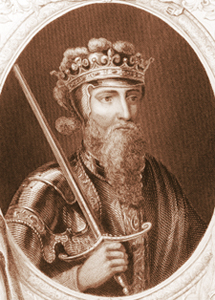King Edward III
 Edward III was born at Windsor on 13 November 1312 and succeeded to the throne of England on 20 January 1327 at the age of 14. He was his father Edward II's eldest son. At the age of 15, at York, Edward married 13-year-old Philippa, daughter of William III of Hainault in Flanders. In his prime, this third Edward was strikingly handsome, of medium height and athletic being a good sportsman, jouster and sailor. Right: Edward III (1312-1377) an engraving from the 1800s.
Edward III was born at Windsor on 13 November 1312 and succeeded to the throne of England on 20 January 1327 at the age of 14. He was his father Edward II's eldest son. At the age of 15, at York, Edward married 13-year-old Philippa, daughter of William III of Hainault in Flanders. In his prime, this third Edward was strikingly handsome, of medium height and athletic being a good sportsman, jouster and sailor. Right: Edward III (1312-1377) an engraving from the 1800s.
Edward had acceded to the throne when his father had been forced to abdicate and for the first few years of his reign, he was under the domination of his mother Isabella and Roger Mortimer, her ambitious lover, the pair of whom had of course masterminded his father's murder. At this time, Isabella and Mortimer still controlled both the government and the Royal revenue. Isabella was later to become known as the 'She Wolf of France'. Edward, probably felt understandably insecure being nearly 17 years old, newly married and already a father, when Mortimer had his uncle, the murdered King's younger brother, Edmund Earl of Kent, executed. After this execution Henry Lancaster prevailed upon the young king to act. Thus, when a parliament was called at Nottingham in October 1330, Edward along with a few friends managed to steal into the castle unnoticed at night and Mortimer and Isabella were seized by Edward and his companions. In spite of Isabella’s entreaty to her son, "Fair son, have pity on the gentle Mortimer," Mortimer was imprisoned in the Tower of London. Accused of assuming royal power and of various other high misdemeanours, Roger Mortimer was summarily condemned without trial and ignominiously hanged at Tyburn on 29 November 1330, his vast estates being forfeited to the crown. Isabella was kept confined for the last 20 years of her life in Castle Rising in Norfolk.
Edward was now free to rule and this he did in some style. He showed no favouritism at court and his interests lay firmly in the direction of most red-blooded Plantagenet males i.e. war and women with a little pageantry and culture in the mix. He gained the support of the barons who welcomed a leader showing all the qualities required of a medieval king. He set out to prove himself in the first instance by once again renewing the war against the Scots. Not long after his accession, he had been forced to sign over Scottish independence at the Treaty of Northampton in 1328 but this did not suit his purposes, besides which he was very concerned about the Scottish-French alliance. David II, a child king had replaced Robert the Bruce on the Scottish throne and Edward used this opportunity to support Edward Balliol's claim to the kingdom and King David was overthrown in 1332. However Balliol's hold on power was not guaranteed and it soon became clear that he needed the help of the English king. This help was forthcoming in July 1333 when Edward inflicted a crushing defeat on the Scots at Halidon Hill Berwick-upon-Tweed effectively ending the wars of Scottish independence. Balliol however was not able to maintain his grip on the kingdom and was deposed for a third and final time in 1336.
Although Edward III committed very large armies to the Scottish campaigns, by 1337 the vast majority of Scotland had been recovered by the forces of David II, leaving only a few castles such as Edinburgh, Roxburgh and Stirling in Plantagenet possession. These installations were not enough to impose Edward's rule and by 1338/9 Edward had moved from a policy of conquest to one of containment. - King Edward III Part 2


